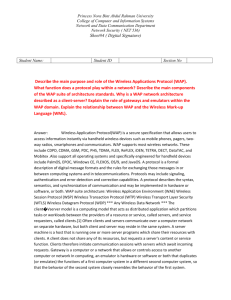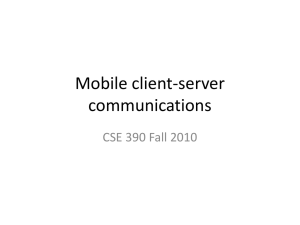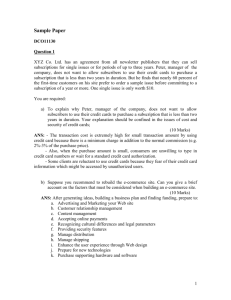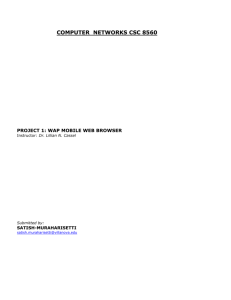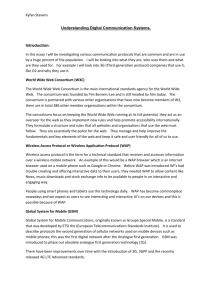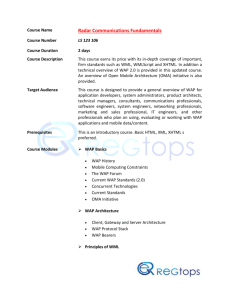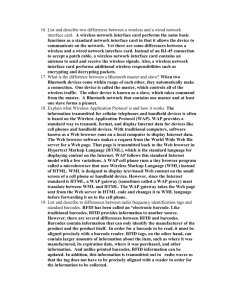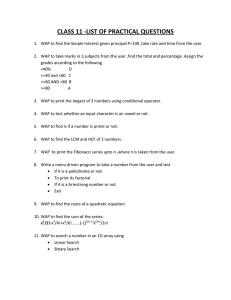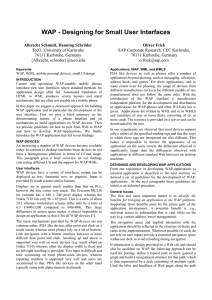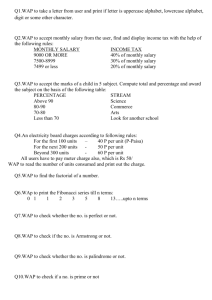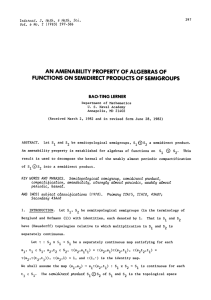FYP LYU0001 Wireless-based Mobile E
advertisement
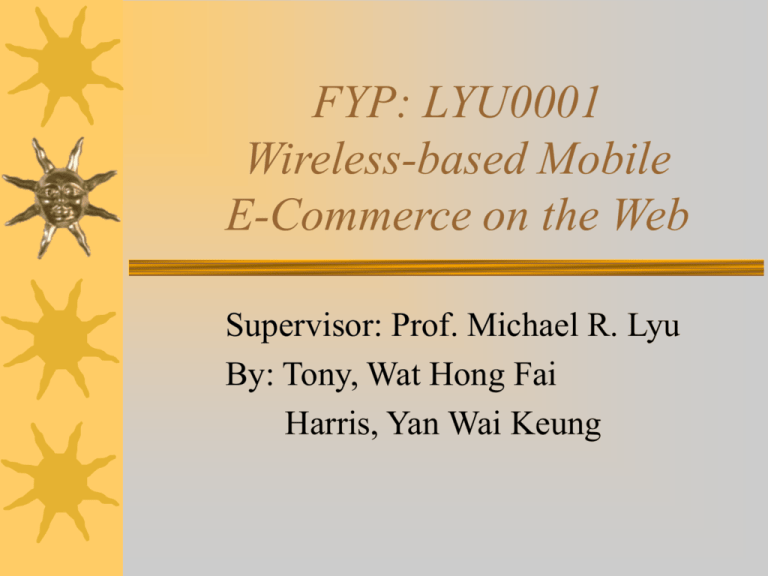
FYP: LYU0001 Wireless-based Mobile E-Commerce on the Web Supervisor: Prof. Michael R. Lyu By: Tony, Wat Hong Fai Harris, Yan Wai Keung Outline Introduction Traditional web access vs mobile access Protocol : WAP WAP architecture, limitation and future E-Commerce Model Our Future work XML, XSL Web Access vs Mobile Access Web vs WAP Different protocols to be used HTML for standard web browser (IE/Netscape) WML for small narrowband device (mobile phone/PDAs) WML is not as visually rich as HTML. WAP WAP – Wireless Application Protocol Based on already existing Internet protocols, but are optimized for mobile users with wireless devices Specification for developing applications over wireless communication networks Translating internet information to display on the screen of mobile phones or other portable device. mobile phone from which you can surf the web, but it is not all the case WAP Architecture(1) A web server can host the WAP A WAP Gateway is an intermediary between the Internet and the mobile network. translates mobile device requests (WAP requests) into HTTP requests, redirects the web-server's HTTP responses to the mobile An Emulator downloads a WML file directly from a web-server WAP Architecture(2) WML WML – Wireless Markup Language Specific type of XML (eXtensible Markup Language) Standardized Document Type Definition (DTD) by W3C Functional Areas: 1. Text presentation and layout 2. Deck/card organizational metaphor, 3. Inter-card navigation and linking 4. String parameterization and state management (WML variables) 5. Interface to phone features WAP Limitation Designed with constraints: 1. Small display and limited input facilities 2. Narrowband network connection 3. Limited memory and computational resources Narrow bandwidth: 9.6kbps GIF format on web Maximum size of each deck: 1.4 Kbytes Recently, only text and monochrome images (.wbmp) are supported WBMP format on WAP WAP Future Recently, WAP(version 1.2) is based on GSM, CDMA or TDMA networks (2G) Later on, gateway can get the user’s information, such as phone number and current location. GPRS (General Packet Radio Service) is a mobile telephony network system that uses packet switched data transmission (2.5G). It provide faster speed (max. 172kbps) and better application can be developed. Eg. Multimedia applications and remote LAN access When 3G is available in the market, it will make video conferencing possible E-Commerce Model Our objective is to practise real life e-commerce with security and payment issues Design and Develop a WAP-based E-Commerce application on the Web A Second hand market application is to be built for real-time interaction, purchasing and transaction with payment Accessible with WAP-enabled device such as mobile phone and PDAs Facilities of the Model(1) Posting products for sale or to request for Secure payment method by Visa/Master card, Mondex Real-time buyer-seller interaction including chatting to bargain for the price Real-time purchasing and make transaction Facilities of the Model(2) Session propagation for convenient and secure operations Provide pictures for web and wap users Store user transaction history and personal profile Future work(1) Implement the online market in both web and WAP versions Customize and personalize the UI of WAP browser to meet complex e-commerce model Use of XML to manipulate the raw data to make it generic for future development on WAP technology Use of XSL for transformation from a XML document to HTML or WML depends on users’ request Future Work(2) Introduction to XML and XSL XML (eXtensible Markup Language) - a meta language used to define other domain- or industry-specific languages - Creating markup languages that describe data - Human readable format - targeted to different devices using XSL - No fixed set of elements - a specific Document Type Definition (DTD) is needed to provide the rules that define the elements and structure Introduction to XSL XSL (eXtensible Stylesheet Language) - is XML - a language for transforming XML documents [XSLT] - an XML vocabulary for specifying formatting semantics [XSL FO (formatting objects)] - A description of how to present the transformed information - a syntax for addressing parts of a document [XPath] Advantages of XML and XSL(1) Use of XML to increase the flexibility on manipulating the raw data Reuse of fragments of data multiple output formats Advantages of XML and XSL(2) styles tailored to the reader's preference (e.g., accessibility) standardized styles freedom from style issues for content authors The End Thank You!
